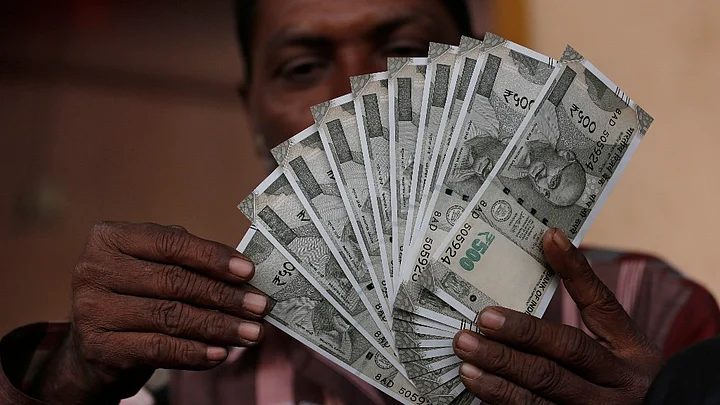Around 200 million pieces of defective Rs 500 notes, one of the two high-value currency notes demonetised by Prime Minister Narendra Modi over a month ago, were produced at Dewas and Nashik currency printing presses, The Quint has reliably learnt.
These remain stockpiled and have not been declared legal tender. However, they are representative of the huge scale of the defective Rs 500 notes printed almost a month after printing of the new Rs 2,000 notes began.
Add to this another 700 million of the old Rs 500 notes printed at Dewas and Nashik, that are now no longer legal tender – an additional cost to the taxpayer of Rs 700 crore.
This brings the cumulative loss to the exchequer to Rs 900 crore, with the face value of the defective printed currency standing at Rs 10,000 crore (200 million x Rs 500), while the face value of the defunct printed Rs 500 notes comes to Rs 35,000 crore (700 million x Rs 500).
Many more millions of defective notes produced at the two bank note printing presses under the aegis of the Security Printing and Minting Corporation of India (Ltd) are in circulation after they were declared legal tender by the Reserve Bank of India.
200 Million Defective New Rs 500 Notes
- Around 200 million pieces of defective new Rs 500 notes were produced at Dewas and Nashik currency printing presses.
- These remain stockpiled and have not been declared legal tender.
- Once the defects were detected and brought to the notice of the RBI, two teams of officials visit the printing presses.
- Dewas BNP had printed 100 million defective pieces of the Rs 500 notes and Nashik CNP too had accumulated about 100 million pieces.
- The main reasons behind the defects was the undue pressure that was exerted on the employees.
- Each piece of the new notes costs approximately Rs 10, amounting to a loss of Rs 200 crore (200 million x Rs 10) to the national exchequer.
‘Reckless Speed to Fill Currency Vacuum’
Senior RBI officials admitted to The Quint that “the reckless speed to fill the currency vacuum” created by the demonetisation of the Rs 1,000 and Rs 500 notes – which accounted for 86 percent of the total currency notes in circulation before the ban – is what caused the printing of the defective notes.
The Quint has previously published a series of reports on how vital stages of the printing of both the Rs 2,000 and Rs 500 notes were done away with in the “massive rush” post-demonetisation.
Also Read: Demonetisation: Corrupt Deal Disrupted Printing of Rs 500 Notes
However, once the defects were detected and brought to the notice of the RBI, two teams of officials from the central bank and the SPMCIL, the latter led by Finance Ministry Joint Secretary (Currency and Coinage) Pravin Garg, visited the Bank Note Press in Dewas (Madhya Pradesh) and the Currency Note Press at Nashik (Maharashtra) to take stock of the total volume of defective Rs 500 notes. The RBI team visited the Dewas and Nashik printing presses on 17 November.
The officials were “shocked” to find that the Dewas BNP had printed, but not sent out, 100 million pieces of the Rs 500 notes, and the Nashik CNP too had accumulated about 100 million of the defective high-value notes.
A preliminary investigation has established that the rush to print the new Rs 500 notes coupled with seemingly reckless operations, including skipping of the vital “colour examination” and “intaglio printing” stages, led to the production of the defective notes.
“Should the government not fix responsibility for the printing of millions of defective notes,” a senior RBI official asked, adding that each piece of the two new notes – Rs 2,000 and Rs 500 – costs approximately Rs 10 to print. This amounts to a loss of Rs 200 crore (200 million x Rs 10) to the national exchequer.
These defective notes are now at the godowns of the two printing presses, awaiting the shredding and bricketing machine. Likewise, the old Rs 1,000 and Rs 500 notes that the banks have collected and will continue to collect till 30 December, will also be shredded and bricketed in Mumbai and Nagpur.
As Many as 10 Defects in New Rs 500
There are as many as ten defects in the new Rs 500 notes. The main reasons behind the defects, according to informed RBI sources, was the undue pressure that was exerted on the employees at the Dewas and Nashik currency printing presses.
They did not get sufficient time to put into operation smooth and flawless printing, as the SPMCIL officials at Dewas and Nashik were handed the new design, the dimensions, and plates of the Rs 500 notes just “seven to ten days” before printing began.
RBI officials suspect that in the first flush of printing at the Dewas and Nashik presses, over 100 million defective Rs 500 notes were produced before they went into circulation. More of the defective notes followed after completion of offset and intaglio printing and numbering before the RBI declared all of them to be legal tender.
RBI sources said that the printing errors and the consequent embarrassment, if not threat to security of the new notes, could have been mitigated had Modi and senior officials of the central bank and the Finance Ministry not taken the decision to change the dimensions of the two new high-value notes.
“The biggest mistake was to print the new Rs 2,000 notes,” a senior official said, adding that “it would be another huge error of judgement to go ahead and print plastic Rs 10, Rs 20 and Rs 50 notes.”
According to the official, unlike the paper notes, the plastic notes cannot be folded several times, which is a “cultural practice” among Indians, especially the women.
(At The Quint, we question everything. Play an active role in shaping our journalism by becoming a member today.)
